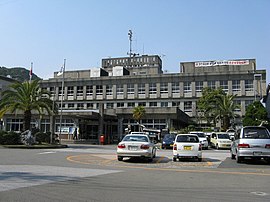Susaki (須崎市, Susaki-shi) is a city located in Kōchi Prefecture, Japan. As of 31 July 2022[update], the city had an estimated population of 20‚429 in 10672 households and a population density of 150 persons per km².[1] The total area of the city is 135.44 square kilometres (52.29 sq mi).
Susaki
須崎市 | |
|---|---|
 View of Susaki city | |
 Location of Susaki in Kōchi Prefecture | |
 | |
| Coordinates: 33°23′33″N 133°17′35″E / 33.39250°N 133.29306°E | |
| Country | Japan |
| Region | Shikoku |
| Prefecture | Kōchi |
| Government | |
| • Mayor | Kosaku Kusunose (since February 2012) |
| Area | |
| • Total | 135.44 km2 (52.29 sq mi) |
| Population (31 July 2022) | |
| • Total | 20,429 |
| • Density | 150/km2 (390/sq mi) |
| Time zone | UTC+09:00 (JST) |
| City hall address | 1-7 Yamate-machi, Susaki-shi, Kochi-ken 785-8601 |
| Climate | Cfa |
| Website | Official website |
| Symbols | |
| Bird | Alcedo atthis |
| Flower | Prunus jamasakura |
| Tree | Cherry blossom |



Geography
editSusaki is located in central Kōchi Prefecture, facing Tosa Bay of the Pacific Ocean to the south and bordered by mountains to the north. Most of the city area is forest. The coastline is intricate, with deep coves such as Uranouchi Bay and Susaki Bay.
Neighbouring municipalities
editKōchi Prefecture
Climate
editSusaki has a humid subtropical climate (Köppen climate classification Cfa) with hot, humid summers and cool winters. There is significant precipitation throughout the year, especially during June and July. The average annual temperature in Susaki is 16.8 °C (62.2 °F). The average annual rainfall is 2,780.2 mm (109.46 in) with September as the wettest month. The temperatures are highest on average in August, at around 27.2 °C (81.0 °F), and lowest in January, at around 6.7 °C (44.1 °F).[2] The highest temperature ever recorded in Susaki was 39.3 °C (102.7 °F) on 8 August 2006; the coldest temperature ever recorded was −5.7 °C (21.7 °F) on 26 February 1981.[3]
| Climate data for Susaki (1991−2020 normals, extremes 1977−present) | |||||||||||||
|---|---|---|---|---|---|---|---|---|---|---|---|---|---|
| Month | Jan | Feb | Mar | Apr | May | Jun | Jul | Aug | Sep | Oct | Nov | Dec | Year |
| Record high °C (°F) | 21.3 (70.3) |
23.5 (74.3) |
27.4 (81.3) |
29.8 (85.6) |
34.2 (93.6) |
35.3 (95.5) |
38.7 (101.7) |
39.3 (102.7) |
35.8 (96.4) |
32.8 (91.0) |
28.8 (83.8) |
23.8 (74.8) |
39.3 (102.7) |
| Mean daily maximum °C (°F) | 12.3 (54.1) |
13.1 (55.6) |
16.1 (61.0) |
20.4 (68.7) |
24.0 (75.2) |
26.3 (79.3) |
30.1 (86.2) |
31.4 (88.5) |
29.1 (84.4) |
24.8 (76.6) |
19.7 (67.5) |
14.5 (58.1) |
21.8 (71.3) |
| Daily mean °C (°F) | 6.7 (44.1) |
7.6 (45.7) |
10.8 (51.4) |
15.3 (59.5) |
19.4 (66.9) |
22.4 (72.3) |
26.2 (79.2) |
27.2 (81.0) |
24.4 (75.9) |
19.4 (66.9) |
13.9 (57.0) |
8.7 (47.7) |
16.8 (62.3) |
| Mean daily minimum °C (°F) | 2.1 (35.8) |
2.8 (37.0) |
5.7 (42.3) |
10.3 (50.5) |
14.9 (58.8) |
19.1 (66.4) |
23.1 (73.6) |
23.8 (74.8) |
20.8 (69.4) |
15.1 (59.2) |
9.3 (48.7) |
4.1 (39.4) |
12.6 (54.7) |
| Record low °C (°F) | −5.5 (22.1) |
−5.7 (21.7) |
−3.0 (26.6) |
0.1 (32.2) |
6.0 (42.8) |
11.7 (53.1) |
16.5 (61.7) |
16.9 (62.4) |
11.2 (52.2) |
4.4 (39.9) |
0.0 (32.0) |
−3.4 (25.9) |
−5.7 (21.7) |
| Average precipitation mm (inches) | 68.3 (2.69) |
99.2 (3.91) |
187.8 (7.39) |
221.6 (8.72) |
275.9 (10.86) |
376.8 (14.83) |
338.2 (13.31) |
326.2 (12.84) |
428.3 (16.86) |
230.2 (9.06) |
141.3 (5.56) |
86.4 (3.40) |
2,780.2 (109.46) |
| Average precipitation days (≥ 1.0 mm) | 6.0 | 7.6 | 10.4 | 10.2 | 10.4 | 14.8 | 12.7 | 12.3 | 13.1 | 8.7 | 7.3 | 6.3 | 119.8 |
| Mean monthly sunshine hours | 187.8 | 177.9 | 197.3 | 197.7 | 203.9 | 140.6 | 184.8 | 213.3 | 161.3 | 178.8 | 168.7 | 182.6 | 2,197.3 |
| Source: Japan Meteorological Agency[3][2] | |||||||||||||
Demographics
editPer Japanese census data, the population of Susaki in 2020 is 20,590 people.[4] Susaki has been conducting censuses since 1920.
| Year | Pop. | ±% |
|---|---|---|
| 1920 | 24,557 | — |
| 1925 | 25,347 | +3.2% |
| 1930 | 25,898 | +2.2% |
| 1935 | 25,998 | +0.4% |
| 1940 | 25,786 | −0.8% |
| 1945 | 33,412 | +29.6% |
| 1950 | 34,113 | +2.1% |
| 1955 | 34,192 | +0.2% |
| 1960 | 32,976 | −3.6% |
| 1965 | 32,020 | −2.9% |
| 1970 | 31,050 | −3.0% |
| 1975 | 31,019 | −0.1% |
| 1980 | 31,852 | +2.7% |
| 1985 | 31,378 | −1.5% |
| 1990 | 30,295 | −3.5% |
| 1995 | 28,742 | −5.1% |
| 2000 | 27,569 | −4.1% |
| 2005 | 26,039 | −5.5% |
| 2010 | 24,698 | −5.1% |
| 2015 | 22,606 | −8.5% |
| 2020 | 20,590 | −8.9% |
| Susaki population statistics[4] | ||
History
editAs with all of Kōchi Prefecture, the area of Susaki was part of ancient Tosa Province. During the Edo period, the area was part of the holdings of Tosa Domain ruled by the Yamauchi clan from their seat at Kōchi Castle. Following the Meiji restoration, the town of Susaki was established within Takaoka District, Kōchi with the creation of the modern municipalities system on October 1, 1889. It was elevated to city status on October 1, 1954.
Government
editSusaki has a mayor-council form of government with a directly elected mayor and a unicameral city council of 15 members. Susaki contributes one member to the Kōchi Prefectural Assembly. In terms of national politics, the city is part of the Kōchi 1st district of the lower house of the Diet of Japan.
Economy
editAgriculture and commercial fishing are mainstays of the local economy, with charcoal production and cement also major contributors.
Education
editSusaki has eight public elementary schools and five public middle schools operated by the city government and one public high schools operated by the Kōchi Prefectural Department of Education. There is also one private combined middle and high school.
Transportation
editRailway
editShikoku Railway Company - Dosan Line
Highways
editSister cities
edit- Castanhal, Pará, Brazil, since October 1, 1979
- Tauranga, New Zealand, since December 19, 1997
Local attractions
edit- Tosa Domain Battery site, National Historic Site
In popular media
editSusaki's official mascot is Shinjo-kun, a Japanese river otter wearing a hot pot ramen dish for a hat. Japanese river otter is an extinct variety of otter, that was last documented in the mouth of the Shinjo River in Susaki.[5][6]
Susaki has hit the worldwide press due to an unofficial mascot, also an otter, named Chiitan. Chiitan is somewhat violent, but in a humorous way. John Oliver has an episode discussing the humor of Chiitan.[7] In May 2019, Chiitan was banned from Twitter for inflammatory content.[8] There is speculation that this disturbing but amusing content can help the city of Susaki, either by attracting tourists or because Japanese can donate a portion of their taxes to cities where they are not resident.[9]
References
edit- ^ "Susaki city official statistics" (in Japanese). Japan.
- ^ a b 気象庁 / 平年値(年・月ごとの値). JMA. Retrieved April 17, 2022.
- ^ a b 観測史上1~10位の値(年間を通じての値). JMA. Retrieved April 17, 2022.
- ^ a b Susaki population statistics
- ^ "Nothing Hotter than an … otter?". Hyper Japan Festival.
- ^ "Profile – Shinjo-kun Official Website" (in Japanese).
- ^ "Chiitan: Last Week Tonight with John Oliver (HBO)". YouTube.
- ^ Ives, Mike (17 May 2019). "Violent Japanese Mascot That Tickled John Oliver is Suspended by Twitter". The New York Times.
- ^ Soble, Jonathan (30 May 2015). "In Japan, You Get a Tax Break and a Side of Lobster and Beef". The New York Times.
External links
edit- Susaki City official website (in Japanese)


